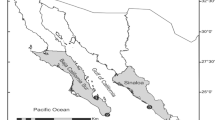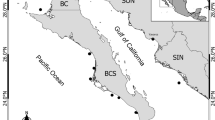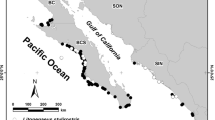Abstract
Mercury and arsenic levels in muscle and liver of Rhinoptera steindachneri were determined in organisms collected in 2006. Element concentrations in both tissues were directly related to size. Maxima mean concentrations of Hg and As (0.41 and 59.9 μg g−1 dry wt, respectively) were found in adults muscle. Mercury concentrations were significantly different between juveniles and adults in muscle and liver. For As concentrations, differences between juveniles and adults were found only in muscle. Mercury concentrations were higher in muscle of juveniles and adults. Arsenic concentrations were higher in liver of juveniles, and in muscle of adults. Maximum Hg concentration in muscle (0.65 μg g−1 dry wt) was below the safe limit established by Mexican regulations for seafood.
Similar content being viewed by others
Explore related subjects
Discover the latest articles, news and stories from top researchers in related subjects.Avoid common mistakes on your manuscript.
Mercury and arsenic are two of the most toxic non-essential elements. Mercury, known to demonstrate biomagnification, can reach high concentrations in top-level predators such as elasmobranches. The accumulation of trace elements in elasmobranches has been studied widely but most of these studies have focused on sharks with few reports on rays (Denton and Breck 1981; Law and Singh 1991). In the Gulf of California (GC), in particular, most trace-metal studies have been performed on bivalves, crustaceans, and fish; only two studies have examined sharks (Cadena-Cárdenas 2004; Ruelas-Inzunza and Páez-Osuna 2005) and only one, rays (Cadena-Cárdenas 2004).
The GC ecosystem has been altered by human settlement and industrial development. In this region, extensive agricultural activity, aquaculture, fisheries, and residential and industrial discharge adversely affect the ecosystem. The discharge from Cerro Prieto geothermal field (a few km north of the gulf) could also be a source of pollutants to water and organisms of the Upper GC (Gutiérrez-Galindo et al. 1988). The present work is aimed at measure the concentrations of Hg and As in muscle and liver tissues of the golden cownose ray Rhinoptera steindachneri, because it is one of the primary components of artisanal elasmobranch fisheries in the GC, and is harvested for human consumption.
Materials and Methods
The Upper GC, is located between 31° and 32° north latitude, and 113° and 115° west longitude; it lies between the mainland México and the peninsula of Baja California. This region is rich in natural resources, has high productivity and biological diversity, and is an important habitat for the reproduction and nursery of a number of endemic species.
Muscle and liver samples from individual rays R. steindachneri (n = 35) were obtained in April and May of 2006 from artisanal fisheries landed at San Felipe port in the Upper GC. Ray size, measured as disc width, ranged between 42 and 91 cm. Juveniles (n = 17) were defined as smaller than 65 cm disc width, and adults (n = 18) as larger than 75 cm as defined by Bizarro et al. (2007). Samples were rinsed with distilled, deionized water, placed in clean plastic bags and stored at −15°C until analysis.
Samples were freeze-dried, and subsequently, homogenized in an agate mortar. Digestion procedures were different for Hg and As. For Hg, each sample (0.15–0.2 g dry tissue) was digested with HNO3 (Omnitrace®) and H2O2 (Perdrogen®) in a microwave oven (Milestone, mod. ETHOS TC) and diluted to 50 mL adding 0.2% HNO3 (Omnitrace®). For As, digestion of muscle was different from digestion of liver. Muscle tissue was digested in open vessels: 0.2 g of dry tissue was treated with 4 mL of 40% (m/v) Mg(NO3)2 · 6H2O and dried at 80°C overnight. Dry residues were ashed at 450°C for 6 h and dissolved with 25 mL of 4 M HCl (Omnitrace®). Livers were pre-treated with HNO3 (Omnitrace®) and H2O2 (Perdrogen®), heated in a microwave oven, dried, and digested as previously described for muscle tissues.
Mercury and As determination were performed in a graphite furnace atomic absorption spectrophotometer (Perkin-Elmer, Analyst 600, with Zeeman background correction) coupled with a vapor/hydride generator (Perkin Elmer mod. FIAS 100). Hg was determined by the cold vapor technique; As was measured as volatile hydrides, after reduction with NaBH4. All material used was “trace-metal” cleaned as described in Gutiérrez-Mejía (2007). To establish the accuracy of the methods certified reference material was analyzed with each batch of samples (Table 1). Procedural blank digests were also prepared and the values obtained were subtracted. Detection and quantification limits were 0.004 and 0.013 μg g−1, respectively, for Hg and 0.67 and 2.24 μg g−1, respectively, for As. Wet/dry relationships were five for muscle and two for liver.
Results and Discussion
Maximum Hg concentrations were found in two adult livers (0.74 and 0.75 μg g−1; Fig. 1a), however, mean liver concentrations (0.13 and 0.30 μg g−1; juveniles and adults, respectively) were lower than those found in muscle tissues (0.20 and 0.41 μg g−1 juveniles and adults, respectively; Table 2). Arsenic concentrations were two orders of magnitude higher than those of Hg. Mean As values for muscle tissue were 21.7 and 59.9 μg g−1 (juveniles and adults, respectively), and for livers were 35.0 and 46.3 μg g−1 (juveniles and adults, respectively; Table 2).
Mercury and As concentrations in R. steindachneri increased with size (age) in both tissues, with high correlation coefficients mainly in the muscle (Fig. 1a, b). Accumulation with age is consistent with a low regulatory capacity; with assimilation greater than excretion. Adults have lower metabolic rates than juveniles; therefore, may take longer to “metabolize” metals, resulting in higher concentrations in older individuals. Also, larger organisms can catch larger preys, with proportionately higher metal concentrations. This tendency has been reported for Hg in rays from the GC including two organisms of the same species studied here (Cadena-Cárdenas 2004), and also for other rays from Malaysia (Law and Singh 1991) and Australia (Denton and Breck 1981), as well for sharks (Cadena-Cárdenas 2004). The situation is less clear with regard to As. In contrast to the positive correlation of disc size and As concentration found in the present work, a negative correlation between these two variables has been reported (Maher et al. 1999). However, Storelli and Marcotrigiano (2004) found a positive linear relationship between sizes and As levels in two of six shark species studied.
The smallest organism presented unexpectedly high Hg concentrations, mainly in the liver (Fig. 1a). R. steindachneri is a placental viviparous species, in which the developing embryo is nourished directly by the mother. Newborn rays are 38–45 cm (Bizarro et al. 2007); the smallest individual ray we studied (42 cm) fell into this range. Transfer of maternal Hg to the embryo was proposed by Cadena-Cárdenas (2004), who found higher Hg concentrations in placental viviparous species such as the one studied here. This hypothesis has not been well documented, however, Denton and Breck (1981) and Adams and McMichel (1999) found high levels of Hg in embryonic sharks as well.
In the present study, the comparison of element concentrations with size resulted in higher correlation coefficients in muscle compared with the liver (Fig. 1a, b). Differences in rate of element accumulation between the two tissues were obtained by contrasting the slopes of the regression lines. The slopes of Hg in muscle and liver (Fig. 1a) were not significantly different (F = 0.47, p > 0.05) which means that Hg is accumulated at the same rate in both tissues. However, the slopes of the regression lines of As (Fig. 1b) were different (F = 7.14, p < 0.01) for the two tissues. Arsenic increased at a higher rate in muscle than in liver.
A two-way ANOVA to compare Hg concentrations, revealed significant differences between groups (juveniles, adults; F = 28.78, p < 0.001) and between tissues (muscle, liver; F = 6.90, p < 0.01). The Tukey tests showed that the differences were between juvenile and adult muscles (p < 0.001; Fig. 2a) and between juvenile and adult livers (p < 0.01). There were no significant differences in Hg concentrations when comparing muscle with liver, in juveniles or in adults (Fig. 2a). Similar tests for As revealed significant differences between groups (F = 29.93, p < 0.001) but no differences in As concentrations between tissues (F = 0.006, p > 0.05). The Tukey tests showed that the only difference was between juveniles and adults muscle tissue (p < 0.001; Fig. 2b).
It is generally accepted that the liver accumulates more trace elements than muscle tissue (Núñez-Nogueira 1995), however, in the present work, Hg accumulation in R. steindachneri was lower in liver in both, juveniles and adults. This observation is consistent with studies performed on sharks (Storelli and Marcotrigiano 2004). Arsenic, on the other hand, was higher in liver, but only of juveniles. Núñez-Nogueira (1995) found higher As concentrations in liver of rays from the Gulf of Mexico. Storelli and Marcotrigiano (2004) found the opposite, that is, lower concentrations in liver than in muscle of sharks from the Mediterranean.
In this study, mercury concentrations in R. steindachneri did not exceed 1 μg g−1 wet wt, the maximum permissible concentration established by the Mexican legislation for seafood (Norma Oficial Mexicana NOM-027-SSA1-1993); the greatest Hg concentrations in muscle were found in a female ray of 87 cm disc width (0.65 μg g−1 dry wt ~0.12 μg g−1 wet wt). Cadena-Cárdenas (2004) found higher values in muscle tissue of two larger organisms (117 and 140 cm; 0.22 and 0.62 μg g−1 wet wt, respectively) of the same species collected in the central part of the GC. These are the largest organisms reported for this species. The Hg concentrations found here for muscle were also lower than those reported for other ray species from the central GC (3.40 μg g−1 wet wt; Cadena Cárdenas 2004), Malaysia (Law and Singh 1991), and Australia (Denton and Breck 1981).
Maximum As concentrations found in muscle and liver (99.2 y 101.8 μg g−1 dry wt, respectively) of R. steindachneri were in the same order of magnitude as those found by other authors in rays (Eisler 1981) and sharks (e.g., Storelli and Marcotrigiano 2004). However, they are much higher than those reported by Núñez-Nogueira (1995) in sharks from the Gulf of México (13.47 and 8.47 μg g−1 dry wt; muscle and liver, respectively).
The high As concentrations found in R. steindachneri can be explained by their diet, because diet is the main source of Hg and As in marine organisms (Storelli and Marcotrigiano 2004). R. steindachneri is both a pelagic and a benthonic feeder, whose diet includes benthonic crustaceans and hard-shell mollusks (Fischer et al. 1995). This ray also feeds close to sediments near to the coast, which makes it vulnerable to effluents with high concentrations of trace elements. It is well recognized that in contrast to piscivores, organisms that feed on cephalopods and crustaceans tend to accumulate As because crustaceans have high concentrations of this element (Storelli and Marcotrigiano, 2004).
There is no established limit for total As in seafood, however, the “Australian Food Standards Code” (Australian New Zealand Food Authority. Food standards codes 1998) establishes a limit of 1 μg g−1 wet wt for inorganic arsenic, the most toxic form. The maximum concentration of total As measured in muscle (99.2 μg g−1 dry wt~19.8 μg g−1 wet wt) in this study was higher than this limit, but the level of inorganic As in our material is unknown. It is recommended that future studies analyze inorganic As to address the issue of safety.
References
Adams HD Jr, McMichel RH (1999) Mercury levels in four species of sharks from the Atlantic coast of Florida. Fish Bull 97:372–379
Australian New Zealand Food Authority. Food standards codes (1998) Standard A12, Issue 37. In: http://www.foodstandards.gov.au/
Bizarro JJ, Smith WD, Márquez-Farias JF, Hueter RE (2007) Artisanal fisheries and reproductive biology of the golden cownose ray, Rhinoptera steindachneri Evermann and Jenkins, 1891, in the northern Mexican Pacific. Fish Res 84:137–146. doi:10.1016/j.fishres.2006.10.016
Cadena-Cárdenas L (2004) Mercurio total en peces elasmobranquios y teleósteos del Golfo de California. BSc Thesis. Instituto Tecnológico del Mar. Guaymas, Sonora. México
Denton GR, Breck WG (1981) Mercury in tropical marine organisms from North Queensland. Mar Pollut Bull 12:116–121. doi:10.1016/0025-326X(81)90439-2
Eisler RA (1981) Trace metals concentrations in marine organisms. Pergamon Press, New York
Fischer W, Krupp F, Schneider W, Sommer C, Carpenter KE, Niem VH (eds) (1995) Guía FAO para la identificación de especies para los fines de la pesca. Pacífico centro-oriental, vol 2. Vertebrados. Parte 1. Roma, FAO
Gutiérrez-Galindo EA, Flores-Muñoz G, Aguilar-Flores A (1988) Mercury in freshwater fish and clams from the Cerro Prieto geothermal field of Baja California, México. Bull Environ Contam Toxicol 41:201–207. doi:10.1007/BF01705431
Gutiérrez-Mejía E (2007) Mercurio y arsénico en tejido muscular y hepático de Rhinoptera steindachneri (Evermann y Jenkins, 1892) en el Alto Golfo de California, México. MSc Thesis. CICESE, Ensenada, México
Law AT, Singh A (1991) Relationship between heavy metal content and body weight of fish from the Kelang Estuary, Malasya. Mar Pollut Bull 22:86–89. doi:10.1016/0025-326X(91)90143-G
Maher W, Goessler W, Kirby J, Raber G (1999) Arsenic concentrations and speciation in the tissues and blood of sea mullet (Mugil cephalus) from Lake Macquarie NSW, Australia. Mar Chem 68:169–182. doi:10.1016/S0304-4203(99)00072-9
Norma Oficial Mexicana NOM-027-SSA1-(1993) Bienes y servicios. Productos de la pesca. Pescados frescos-refrigerados y congelados. Especificaciones sanitarias. In: http://www.salud.gob.mx/unidades/cdi/nom/027ssa13.html
Núñez-Nogueira G (1995) Concentración de As, Cd, Cu, Fe, Hg, Mn, Pb, Se y Zn en cerebro, branquias, músculo, páncreas, riñón e hígado de dos especies de tiburones del Golfo de México (Rhizoprionodon terranovae y Charcharinus limbatus) con importancia comercial. BSc Thesis. Universidad Nacional Autónoma de México. México
Ruelas-Inzunza J, Páez-Osuna F (2005) Mercury in fish and shark tissues from two coastal lagoons in the Gulf of California, México. Bull Environ Contam Toxicol 74:294–300. doi:10.1007/s00128-004-0583-x
Storelli MM, Marcotrigiano GO (2004) Interspecific variation in total arsenic body concentrations in elasmobranch fish from the Mediterranean Sea. Mar Pollut Bull 48:1145–1167. doi:10.1016/j.marpolbul.2004.03.005
Acknowledgments
This research was supported by the research grant CONACYT-SEMARNAT-2002-C01-1129. Thanks to P. Sánchez for critically reading the manuscript. Thanks to Blue Pencil Science for editing this manuscript.
Author information
Authors and Affiliations
Corresponding author
Rights and permissions
About this article
Cite this article
Gutiérrez-Mejía, E., Lares, M.L. & Sosa-Nishizaki, O. Mercury and Arsenic in Muscle and Liver of the Golden Cownose Ray, Rhinoptera steindachneri, Evermann and Jenkins, 1891, from the Upper Gulf of California, México. Bull Environ Contam Toxicol 83, 230–234 (2009). https://doi.org/10.1007/s00128-009-9730-8
Received:
Accepted:
Published:
Issue Date:
DOI: https://doi.org/10.1007/s00128-009-9730-8






